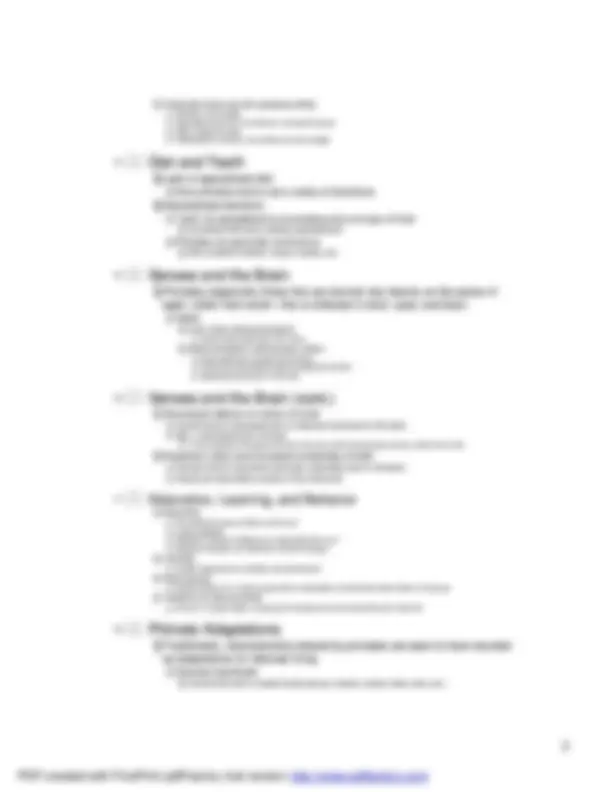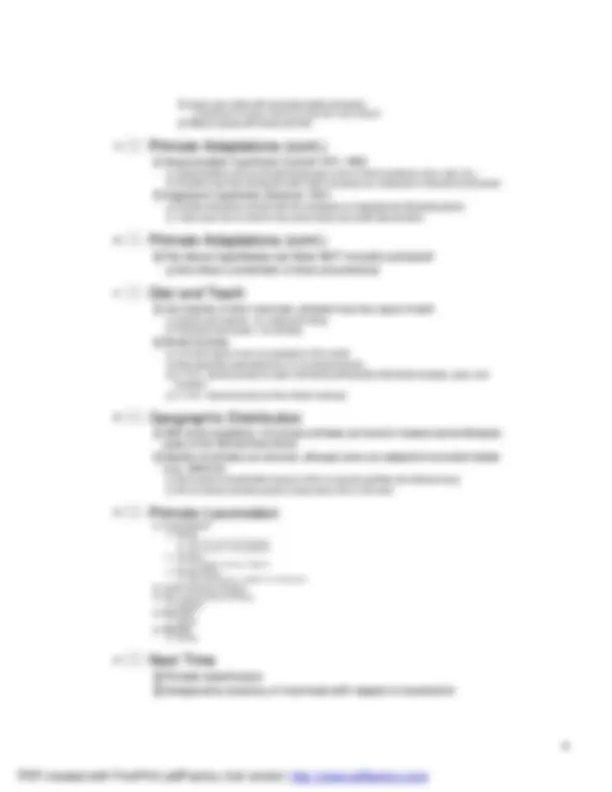





Study with the several resources on Docsity

Earn points by helping other students or get them with a premium plan


Prepare for your exams
Study with the several resources on Docsity

Earn points to download
Earn points by helping other students or get them with a premium plan
Community
Ask the community for help and clear up your study doubts
Discover the best universities in your country according to Docsity users
Free resources
Download our free guides on studying techniques, anxiety management strategies, and thesis advice from Docsity tutors
An overview of primates, focusing on how we study them and their evolution. Topics include the comparative method, primate characteristics, and their place in the mammalian radiation. It also covers the general characteristics of placental mammals and primates, as well as their adaptations.
Typology: Study notes
1 / 5

This page cannot be seen from the preview
Don't miss anything!




§§ Intermediate forms b/t reptiles and mammalsIntermediate forms b/t reptiles and mammals §§ Small, endothermic, insectivores animalsSmall, endothermic, insectivores animals
§§ Adaptive radiation: relatively rapid expansion and diversificatAdaptive radiation: relatively rapid expansion and diversification of an evolving group ofion of an evolving group of organisms as they adapt to new ecological nichesorganisms as they adapt to new ecological niches
2
(^8) The Placental MammalsThe Placental Mammals
§ § Most common groupMost common group § § (^) Distributed all over the worldDistributed all over the world
§ § Over 20 orders of mammalsOver 20 orders of mammals
(^9) General Characteristics of Placental MammalsGeneral Characteristics of Placental Mammals
§§ Ability to maintain a constant internal body temperature throughAbility to maintain a constant internal body temperature through metabolism (homeothermy)metabolism (homeothermy)
(^10) PrimatesPrimates
§ § Look at characteristics that, taken together, separate primatesLook at characteristics that, taken together, separate primates from other mammalsfrom other mammals § § (^) Primates have remainedPrimates have remained (^) generalizedgeneralized §§ Retain “primitive” traits that other species have lost over timeRetain “primitive” traits that other species have lost over time, while becoming more, while becoming more specializedspecialized §§^ Example: development of hooves on many prey speciesExample: development of hooves on many prey species §§ Good adaptation for those needing speed and stabilityGood adaptation for those needing speed and stability §§ Lose the ability to manipulate objectsLose the ability to manipulate objects §§^ PrimitivePrimitive^ doesn’t have a inherent value, but that the traits were presentdoesn’t have a inherent value, but that the traits were present in ancestral formsin ancestral forms
(^11) PrimatesPrimates
§ § Because not so specialized, primates can not be described by oneBecause not so specialized, primates can not be described by one or twoor two shared traitsshared traits § § Biologists use a group of traits that, more or less, apply to prBiologists use a group of traits that, more or less, apply to primatesimates
(^12) Primate CharacteristicsPrimate Characteristics
§ § Again, no one feature distinguishes primates from other mammalsAgain, no one feature distinguishes primates from other mammals (except possibly(except possibly
§ § W. E. LeGros Clark (early comparative anatomist and paleoanthropW. E. LeGros Clark (early comparative anatomist and paleoanthropologist)ologist) §§ Defined primates based on evolutionary trends or traits which toDefined primates based on evolutionary trends or traits which together make up the “primategether make up the “primate pattern”pattern” §§^ Most traits related to skeletal morphologyMost traits related to skeletal morphology § § Adaptations reflected in…Adaptations reflected in… §§ Limbs and locomotion, teeth and diet, senses, brain, and behavioLimbs and locomotion, teeth and diet, senses, brain, and behaviorr
(^13) Limbs and LocomotionLimbs and Locomotion
§§^ Mostly of the upper bodyMostly of the upper body §§ Shown to some degree in all primatesShown to some degree in all primates §§^ Variously associated with sitting, leaping, standing, and occasiVariously associated with sitting, leaping, standing, and occasional bipedal walkingonal bipedal walking
§§ Allows for engaging in a variety of locomotor behaviorsAllows for engaging in a variety of locomotor behaviors
4
§§ Beneficial for complex, 3D environments with unsure footholdBeneficial for complex, 3D environments with unsure foothold
(^19) Primate Adaptations (cont.)Primate Adaptations (cont.)
§ § VisualVisual--predation hypothesis (Cartmill 1972, 1992)predation hypothesis (Cartmill 1972, 1992) §§ Characteristics such as forwardCharacteristics such as forward--facing eyes occur in other predators (cats, owls, etc.)facing eyes occur in other predators (cats, owls, etc.) §§ Primates may have developed other traits not purely as a responsPrimates may have developed other traits not purely as a response to arboreal environmente to arboreal environment § § (^) Angiosperm hypothesis (Sussman 1991)Angiosperm hypothesis (Sussman 1991) §§^ Primate characters evolved with the emergence of angiosperms (flPrimate characters evolved with the emergence of angiosperms (flowering plants)owering plants) §§ Traits arose due to need for fineTraits arose due to need for fine--tuned visual and tactile discriminationtuned visual and tactile discrimination
(^20) Primate Adaptations (cont.)Primate Adaptations (cont.)
§ § The above hypotheses are likely NOT mutually exclusive!The above hypotheses are likely NOT mutually exclusive!
(^21) Diet and TeethDiet and Teeth
§ § Like majority of other mammals, primates have four types of teetLike majority of other mammals, primates have four types of teethh §§ Incisors and canines: for cutting and bitingIncisors and canines: for cutting and biting §§ Premolars and molars: for chewingPremolars and molars: for chewing § § (^) Dental formulaeDental formulae §§ # of tooth types in any one quadrant of the mouth# of tooth types in any one quadrant of the mouth §§ Most placental mammals have 3:1:4:3 dental formulaMost placental mammals have 3:1:4:3 dental formula §§^ 2:1:2:32:1:2:3——dental formula for adult, Old Worlddental formula for adult, Old World^ anthropoidsanthropoids^ (Old World monkeys, apes, and(Old World monkeys, apes, and humans)humans) §§ 2:1:3:32:1:3:3——dental formula for New World monkeysdental formula for New World monkeys
(^22) Geographic DistributionGeographic Distribution
§ § (^) With some exceptions, nonWith some exceptions, non--human primates are found in tropical and semitropicalhuman primates are found in tropical and semitropical
§ § Majority of primates are arboreal, although some are adapted toMajority of primates are arboreal, although some are adapted to terrestrial habitatterrestrial habitat
§§ Some spend considerable amount of time on ground (gorillas and cSome spend considerable amount of time on ground (gorillas and chimpanzees)himpanzees) §§ All nonAll non--human primates spend at least some time in the treeshuman primates spend at least some time in the trees
(^23) Primate LocomotionPrimate Locomotion
§§ QuadrupedalismQuadrupedalism §§^ ArborealArboreal §§ FastFast——as in some monkey speciesas in some monkey species §§ SlowSlow——as seen in many prosimiansas seen in many prosimians §§ TerrestrialTerrestrial §§ On fingertipsOn fingertips——as seen in baboonsas seen in baboons §§ KnuckleKnuckle--walkingwalking §§ African great apes (i.e., gorillas and chimpanzees)African great apes (i.e., gorillas and chimpanzees) §§ Vertical clinging and leapingVertical clinging and leaping §§ Slow, quadrumanous climbingSlow, quadrumanous climbing §§ OrangutanOrangutan §§^ BrachiationBrachiation §§ GibbonsGibbons §§^ BipedalityBipedality §§^ HumansHumans
(^24) Next TimeNext Time
§ § Primate classificationPrimate classification § § Comparative anatomy of mammals with respect to locomotionComparative anatomy of mammals with respect to locomotion
5
§ § Overview of the extant primatesOverview of the extant primates